Page 32 of 33 pages « First < 30 31 32 33 >
Blue bowl 1600-1700, Ming or Qing dynasty
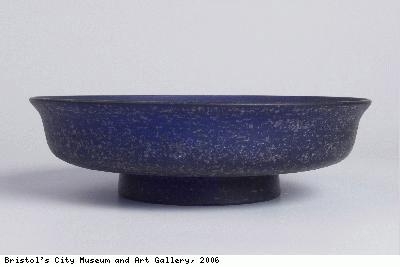
Description:
The foot of this shallow blue bowl was made separately to the bowl and was ‘backed-on’ after the body of the bowl was formed.
A process known as crizzling has damaged the surface of this bowl. Crizzling can occur when the ingredients used to make the glass are not used in the correct quantities: in time, moisture is lost from the glass and the surface flakes away. In the early Qing period (1688-1911), European Jesuits introduced new recipes for making glass. It is possible that the crizzling here is the result of Chinese craftsmen experimenting with these new recipes.
Glass
Height: 5.3 cm, diameter: 18.0 cm
Chinese Description:
玻璃碗 中国,明朝或清朝,约 1600-1700 这玻璃碗因侵蚀而呈龟裂状。大抵其原料配方有误,以致随时间增长,玻璃内部溶解而流失黏液引以致器皿表层剥落。 玻璃Creator: Unknown
Date: 1600-1700, Ming or Qing dynasty
Copyright: Bristol Museums, Galleries & Archives
Object ID:N4793
Turquoise dish
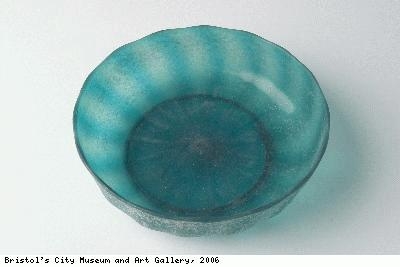
Description:
To make this bowl glass ribs were trailed onto a ball of molten glass. The glass was then rolled against a polished iron or marble surface called a marver. This process made the ribs blend into the body of the vessel creating gentle ridges. The glass was then blown into shape and a strand of glass was trailed onto the base of the dish to make a foot-ring for it to stand on.
Glass
Height: 4.1 cm, diameter: 14.3 cm
Chinese Description:
玻璃碟 中国,清朝,约1700-1730 这只玻璃碟制作繁复,工匠先将玻璃丝拖曳至烧熔玻璃球上,再反覆将之滚动于平滑铁板或云石块,使玻璃丝粘附于胎体。其后工匠又将玻璃吹制成碗状,并于底部加上圈足。 玻璃Creator: Unknown
Date: 1700-1730, Qing dynasty
Copyright: Bristol Museums, Galleries & Archives
Object ID:N4603
One of a pair of octagonal cups
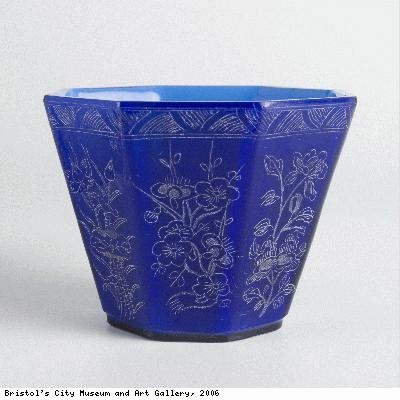
Description:
The diamond-engraved flower sprays in each panel depict the Flowers of the Four Seasons: prunus, camellia, peony and lotus. Diamond point engraving was fashionable in Europe in the 17th and 18th centuries. European craftsmen probably introduced the technique to China.
Some experts have suggested that these cups fit the description of some cups on a list of presents sent to the King of Portugal by the Kangxi emperor in 1722 “Eight small cups with flower [pattern], the colour of blue sky after rain.”
Glass, diamond-point engraved
Height: 5.5 cm, diameter: 7.1 cm
Chinese Description:
八角杯一对 中国,清朝,约1730-1770 这对八角杯各面分别以钻石点刻雕饰成梅花、茶花、牡丹及莲花的四季花卉。钻石点刻法盛行于十七、十八世纪的欧洲,此技法大抵由欧洲工匠引入中国。 玻璃,钻石点刻Creator: Unknown
Date: 1730-1770, Qing dynasty
Copyright: Bristol Museums, Galleries & Archives
Object ID:N4550
Vase with spiral bands of red, blue and turquoise
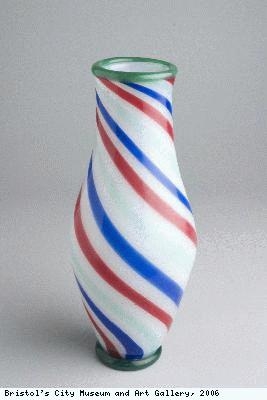
Description:
This vase with its spiral bands of red, blue and turquoise shows the influence of European glass-makers at the imperial glass workshops in Beijing. There is a vase of similar design in the collection of the Palace Museum, Beijing.
Glass, blown
Four-character incised mark of Qianlong period (1736-1795), arranged as on a Chinese coin
Height: 22.8 cm, diameter: 9.2 cm, neck diameter: 5.6 cm
Creator: Unknown
Date: Qianlong period (1736-1795)
Copyright: Bristol Museums, Galleries & Archives
Object ID:N4746
‘Olive’-shaped yellow vase
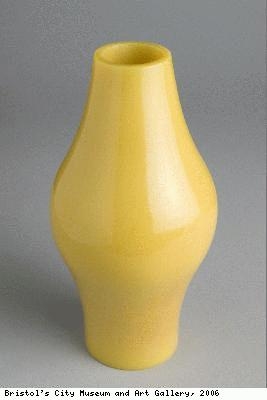
Description:
In China vases with bulbous middles like this are called ‘olive’-shaped.
Glass
Height: 14.6 cm, diameter: 7.1 cm, neck diameter: 3.1 cm
Four-character mark of Qianlong reign (1736-1795)
Chinese Description:
玻璃瓶 中国,清乾隆朝(1736-1795) 在中国,这类中腹微鼓的瓶子称为「橄榄瓶」。 刻有「乾隆年制」四字 玻璃Creator: Unknown
Date: Qianlong reign period (1736-1795)
Copyright: Bristol Museums, Galleries & Archives
Object ID:N4765
Huqqah base
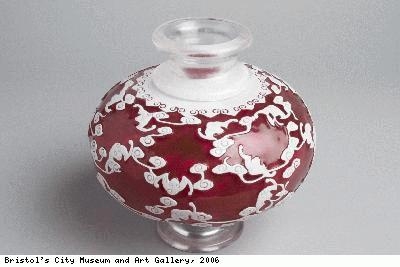
Description:
A huqqah is a pipe used for smoking, with a water container (called a huqqah base) and a long flexible pipe. The Arabic inscription underneath this huqqah base reads ‘from (?) the death of the Prophet year 1172’ (wafaat rasuul dm 1172 sanah). This could mean the year 1758-9, 1804 or 1768-9 depending on how one interprets it. It may have been made for a Chinese Muslim, perhaps one of the Uyghur minority from Turkestan whom the Qianlong emperor integrated into the imperial hierarchy. Uyghur people use the Arabic alphabet to write their language. Qianlong had a Uyghur Muslim concubine, Rong Fei (or Xiang Fei) who lived in his palace from 1760-1788.
Glass
Height: 15.0 cm, diameter: 15.0 cm, neck diameter: 6.4 cm
Inscription in Arabic on base wafaat rasuul dm 1172 sanah (From (?) the death of the Prophet year 1172)
Chinese Description:
回族水烟座 中国,清乾隆朝 (1736-1795),约1768、69 (?) 这水烟座的底部刻有阿拉伯文,意谓自先知之死1172年,可推测为1758-59、1804或1768-69。乾隆曾将来自土尔其斯坦的维吾尔族纳入清朝所管辖,这器皿或为当地中国回教徒所用 玻璃Creator: Unknown
Date: Qianlong reign period (1736-1795)
Copyright: Bristol Museums, Galleries & Archives
Object ID:N4788
Bottle with lobed body
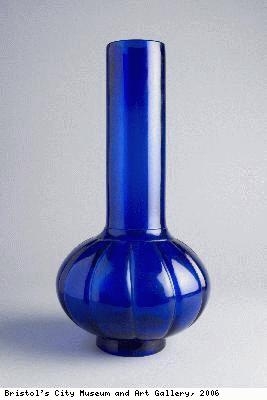
Description:
The blue colour was made by adding the cobalt oxide to clear glass. The lobed body and long neck give the bottle a Middle Eastern look. The glass-makers may have been influenced by glass imported from Iran and elsewhere.
Glass, carved
Height: 30.3 cm, diameter: 15.5 cm, neck diameter: 5.7 cm
Six-character mark of Yongzheng reign (1723-1735)
Chinese Description:
瓜棱瓶 中国,清雍正朝 (1723-1735) 这蓝色花瓶加入氧化鈷,使玻璃色深而透光。其直颈、瓜棱腹的样式颇富中东风味,或许工匠的灵感乃来自伊朗一带入口的玻璃制品。 刻有「大清雍正年制」 玻璃,雕刻Creator: Unknown
Date: Yongzheng reign period (1723-1735)
Copyright: Bristol Museums, Galleries & Archives
Object ID:N4573
Altar vessel
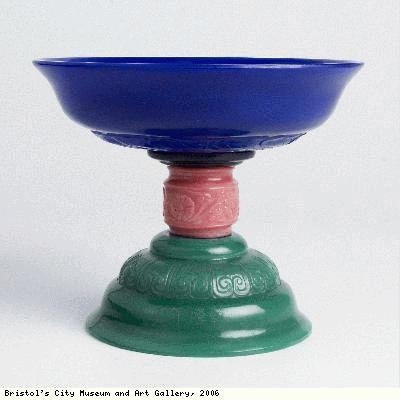
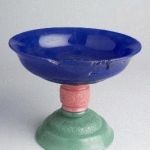
Description:
Altar vessels like this were in demand in the imperial palace in Beijing to place before Buddhist altars. They would have been piled with offerings such as fruit. Each of the three glass sections was made separately then they were joined together with a wooden dowel and glue.
Glass
Height: 12.9 cm, diameter: 15.5 cm, base diameter: 10.8 cm
Four-character mark of Qianlong reign (1736-1795)
Chinese Description:
三件式祭器 中国,清乾隆朝 (1736-1795) 北京玻璃厂制造了不少这类祭器,以俾朝廷用以安放于佛教祭坛上。这祭器形制精巧,先制作配件,再用木榫及胶浆组合而成。 刻有「乾隆年制」四字 玻璃Creator: Unknown
Date: Qianlong reign period (1736-1795)
Copyright: Bristol Museums, Galleries & Archives
Object ID:N4574, N4575
Hairpin with dragon-head
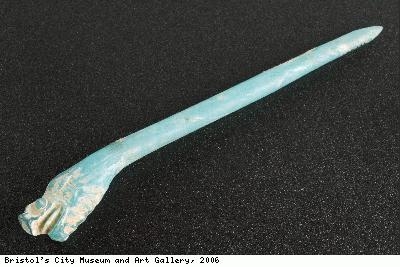
Description:
This hairpin might have been for a man or a woman. It was probably found in a burial site. During the Ming dynasty (1368-1644) wealthy people were buried with everything they might need in the afterlife, including jewellery and dress accessories. The dragon head was made using a two-part mould.
Glass, press-moulded
Length: 11.0 cm, width: 1.7 cm, depth: 1.1 cm
Chinese Description:
龙首发朁 中国,大约出于山东淄博,明代(1368-1644) 明代富人多以起居用品、衣物佩饰等入葬,以便死后于阴间敷用。这只发朁大抵自墓葬遗址出土,但却无法查知为是否男士佩饰。 玻璃, 铸模Creator: Unknown
Date: Possibly Ming dynasty (1368-1644)
Copyright: Bristol Museums, Galleries & Archives
Object ID:N4801
Burial accessory in the shape of cicada
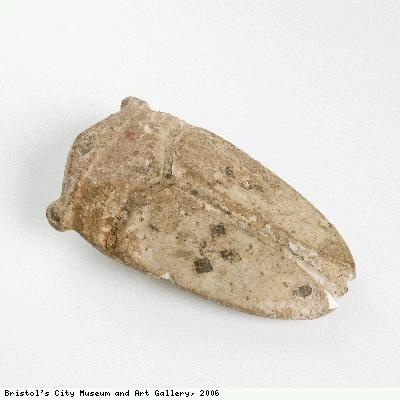
Description:
In ancient China cicadas were symbols of re-birth because of their unusual life cycles.
Young cicadas spend many years underground as larvae before they crawl out and shed their skins, emerging as winged adults.
The dead were often buried with small objects in the shape of cicadas on their tongues in the hope that they would be re-born. The wealthiest people were buried with jade cicadas. These are glass versions which were cheaper to make.
The details of the design was cut by placing the glass against a fast spinning wheel covered with abrasive sand. Black pigment has been applied to the body of the cicada for extra decoration.
Glass, wheel cut
Width: 3.0 cm, length: 5.6 cm, depth: 0.9 cm
Chinese Description:
琀蝉 中国,大约公元100-300年,东汉晚期(公元25-220年)或西魏(公元265-316年) 蝉的生命周期与众不同,在古代中国被视为重生的象征。幼蝉在地下蛰伏数载,才爬出地面蜕变成一只长有翅膀的成虫。 死者下葬时,多在舌头放置一只蝉形饰物,祈求得以再生。 玻璃,轮刻Creator: Unknown
Date: About 100-300 A.D.
Copyright: Bristol Museums, Galleries & Archives
Object ID:N4808

